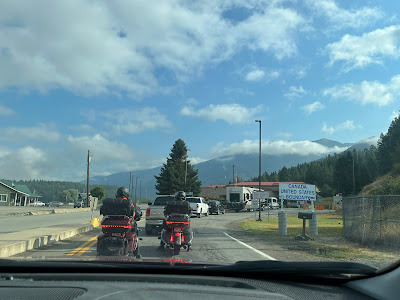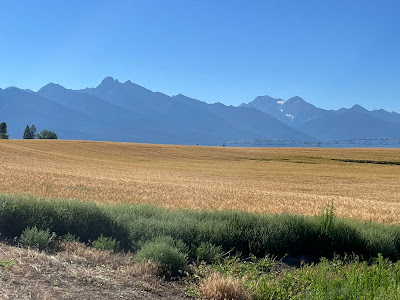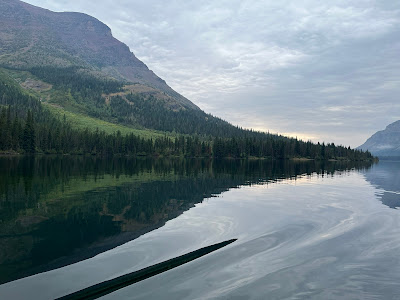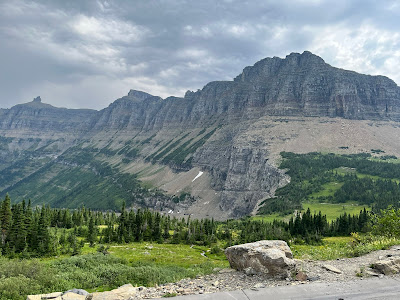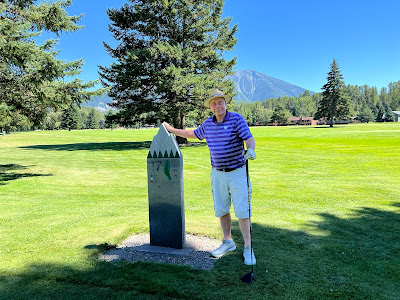O Canada!
After we left Glacier National Park, our adventure included a brief foray across the Montana-Canadian border. In anticipation of our summer trip, we had renewed our passports. We got our first passports in 2010. At the time, Randy was a board members for the Kansas Association of Wheat Growers, and a fellow board member suggested we have passports ready, just in case there was an opportunity for a trade mission or international meeting.
There was not. The 2010 passports sat unused in the bank safety deposit box until they expired. Extensive travel doesn't mix with farming and caring for a cow-calf herd. So, since our travels to Glacier took us close to the Canadian border, Randy added a brief trip into Canada on our itinerary.When it was our turn at the border window, the Canadian Mountie asked us: "How long will you be in Canada?"
Randy said, "Oh, maybe 30 minutes."
That caused the Mountie to pause and then say, "You can't get anywhere in 30 minutes. Are you meeting someone?"
"No," replied Randy.
"Are you going to pick anything up?"
"No," Randy said again.
Finally, I told him: "We've never used our passports, so we want to use them for the first time."
He handed the passports back and admitted us.
However, much to Randy's disappointment, the Mountie did not stamp our passports. So, we still have blank passport pages.
The Mountie might not have thought there was anything to see in 30 minutes in Canada. But we Kansas farmers liked seeing the Canadian farmsteads and fields nestled beneath mountains that seemed to be playing hide-and-seek with quick-moving clouds.
 |
| Taken through the windshield, so it's a little blurry. |
The fields were broken up by the mountains, much different than the large, flat fields we are used to in south central Kansas.
Our little trip into Canada added a wish to Randy's bucket list - a moose sighting.
That wish was not fulfilled. (We have plenty of deer sightings in Kansas, and it's always our hope they they are not spotted darting out in front of our car at dusk. Same goes for the moose!)
As it turned out, we spent about an hour in Canada. (Randy obviously didn't factor in stops for photos.)
The U.S. border agent asked if we'd bought anything in Canada.
"No," we replied. And, evidently, that was enough for him. He let us back in.
Welcome back to the good ol' U.S. of A.!
***
That was not the first time I took photos of farm ground on the trip. As we were arriving in Montana, we kept seeing uncut wheat fields. After attempting several shots at 80 MPH, I couldn't resist having Randy pull over for a photo of a Montana wheat field. It looked a little different with mountains in the background! We're not sure whether it was spring wheat or winter wheat, but there was still some green. I "searched it up" (as Brooke would say) when we got home, and learned that harvest in Montana usually occurs from August to October, depending on the year. In addition, Montana ranks fourth in the United States in wheat production, following Kansas, North Dakota and Oklahoma.We had to send a picture to our kids and to Tye, saying that you could take the Kansas farmers out of Kansas, but we'd still find a farm!
On the way home, we saw a combine cutting wheat in Wyoming. I didn't get a photo of that. At about the same time we were in Montana, Jill, Eric and the girls were in Oregon. Eric sent us a harvest photo from there.
 |
| Harvest in Oregon - from Eric |
I told him he won the son-in-law of the year award for a harvest report. (We've trained him well evidently.)
Several of the ranches in Montana and Wyoming had big signs over their entrances. That reminded Randy of a story from his childhood. He told his dad he thought they should erect a huge sign over their driveway with their name on it, like those announcing the names of ranches in the westerns he watched on TV. Melvin told him it wouldn't make their place any more of a farm or ranch than it already was.
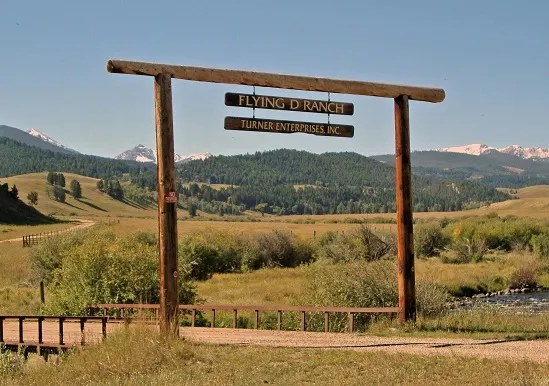 |
| Google Image (my photos didn't turn out) |
"It would be like a guy with a huge cowboy hat and fancy boots ... and no cattle."
As Randy got older, he saw the practicality of his dad's stance. It would just be one more thing to avoid when pulling a big piece of equipment. It seems plenty of our hired helpers throughout the years had difficulty avoiding things like fence posts ... and even power poles.
However, they do believe in big log-framed signs in Montana and Wyoming.
